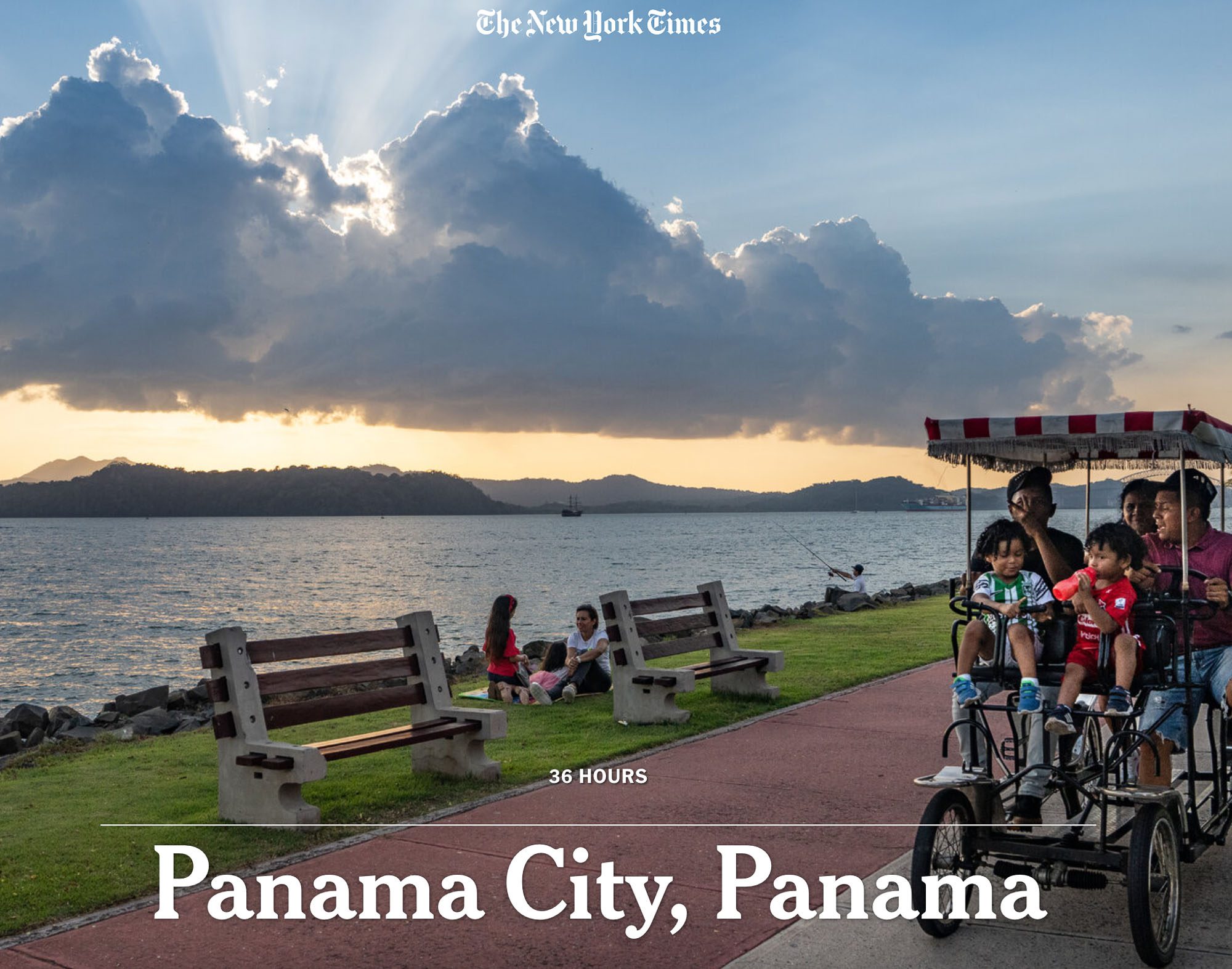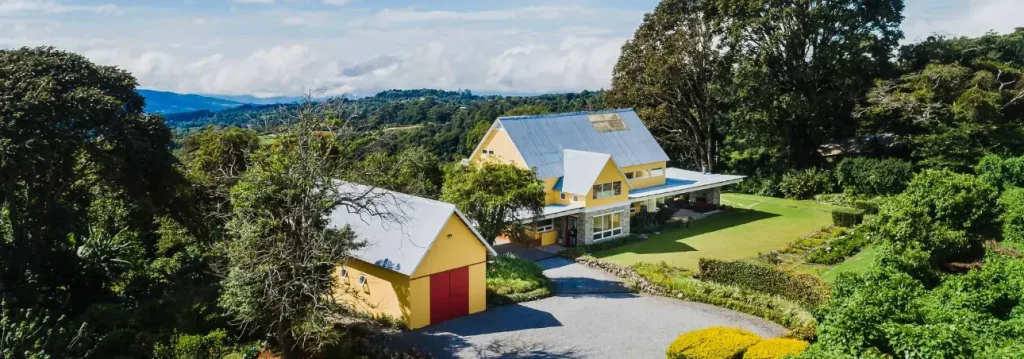6:30 p.m. Circumnavigate the Old Town
A generation ago, Casco Viejo, the Old Town, was considered a crumbling relic. But in 1997, the historic district, which is the oldest surviving European settlement on the Pacific Coast of the Americas, became a UNESCO World Heritage Site. Since then, many of its striking structures have been restored and — for better or worse — reborn as foreign-owned boutique hotels and upscale cafes. Wander with your eyes up (avoiding the occasional sidewalk hole), delighting in the Spanish Colonial, French and Caribbean architecture and plant-draped balconies. Stroll to the walled waterfront of Paseo de las Bóvedas at dusk, when the bird chorus competes with urban traffic. Before dinner, stop at Mayda bar inside the Sofitel Legend, a new hotel in a 1917 building and former social club that features a floor-to-ceiling, hand-painted tile mural of the Panama Canal project.
8:30 p.m. Taste the Panamanian story
Fonda Lo Que Hay, a sultry and perpetually bustling restaurant in Casco Viejo, is a pandemic pivot. Early in 2020, the chef José Olmedo Carles had just expanded his widely acclaimed prix-fixe restaurant, Donde José. When the business was walloped by the pandemic, he rebuilt it as Lo Que Hay, a name that translates roughly to “that’s what there is.” More casual that its predecessor but no less ambitious, the “fonda” (what Panamanians call an inexpensive roadside canteen, although Mr. Carles says the name is mostly nostalgic) serves shareable dishes that include a cassava tostada topped with tuna carpaccio ($15), a pork belly guacho (Panamanian rice porridge) with airy chicharrón ($15) and two flawless pieces of fried chicken with silky mashed potatoes and gravy ($16) that invoke the long U.S. presence in Panama.
Saturday
8 a.m. Sip the exceptional
In Cangrejo, Mentiritas Blancas is a homey neighborhood coffee house (whose name translates to “Little White Lies”) that roasts its own beans and is owned by a trio of siblings who run it like a living room where all are welcome. One wall is papered with notes left by customers, another has illustrations of the small-scale coffee farmers the cafe works with. In the last two decades, Panamanian Geisha (or Gesha) coffee beans — a variety which originated in Ethiopia but thrive in Panama’s high-altitude, volcanic soil — have soared in global prestige and price. (Last year, a pound of exclusive, specially processed Geisha sold for a record-breaking $6,034.) You can have breakfast at the cafe and on your way out buy a bag of coffee beans (including its Geisha, $35 per pound) in floral-printed packaging, a dream gift for a coffee-loving friend.
9:30am Take a passage to the past
Panamá Viejo, an archeological site at the edge of a mangrove forest, preserves the remnants of Panama City’s earliest Spanish settlement, founded in 1519. The city was raided and destroyed by the pirate Henry Morgan in 1671 and later relocated to Casco Viejo. The 79-acre ruins are now littered with fallen mangoes and draped with banyan vines, and its excavated structures are marked with in-depth signs. (Adult tickets, $10; children, $3.) The Museum of the Plaza Mayor (admission included), which opened at the site in 2017, also delves into the site’s pre-Hispanic history and the region’s Indigenous peoples, who began farming and fishing the muddy flats of Panama Bay more than 1,500 years ago. Climb the nearly 100-foot-high cathedral bell tower for a glimpse of the city to the southwest.
1 p.m. Linger over lunch
Don’t be surprised if the taxi driver seems confused when you pull up at Maito in the lush Coco del Mar neighborhood. From the street, the celebrated restaurant looks like a gravel lot backed by a thicket of bamboo. That lack of pretense extends inside, where families gather on the expansive patio for a leisurely meal beneath a corrugated roof, fans whirring slowly overhead and not a white tablecloth in sight. Attentive servers wear black dress shirts and the chef Mario Castrellón’s tasting menu ($75) turns regional dishes of Panama and the Caribbean into museum pieces. Two standouts from the a la carte menu: “ceshimi” (a portmanteau of ceviche and sashimi) that has paper-thin slices of corvina fish, red onion and jalapeño ($15), and pillowy shrimp wontons with passion fruit sauce ($9).
4 p.m. Skip the tchotchkes
Because no one needs more knick-knacks, stop into CACAO Bar Selection, a tiny chocolate shop and cafe in San Francisco, for edible souvenirs. The shop features hundreds of bite-sized, multicolored chocolates, made by the craft chocolate brand Oro Moreno, in Central American flavors like culantro (a pungent herb), coconut and curry, and aji chombo, the fruity chile pepper that stars in the orange hot sauce on many Panamanian tables. Chocolates are available to buy individually ($2 each) or by the box: The bright, lacquered wood “Fauna Panameña” sets — illustrated with jungle scenes — start at $22.
6:30 p.m. Go old school
El Trapiche, a family-style restaurant, and now a small chain, that serves unpretentious Panamanian food, celebrates its 40th anniversary this year. The Vía Argentina location is the original, with the charmingly worn leather chairs and the formica table tops to prove it (a framed photograph of the boxer and favorite son Roberto Duran also hangs on the restaurant’s wall). On any given night here, you might see canoodling couples, foreign students and a Panamanian celebrity all dining within arms length of each other. The wide-ranging menu includes a hearty hojaldra sandwich, a Panamanian fry bread stuffed with a variety of fillings (including Creole-seasoned meats, fried plantains and black beans, from $5.50). Then, en route to Casco, stop at Keene’s, an ice cream shop that’s locally beloved for its changing assortment of bright, tropical flavors.
10:30 p.m. Love the nightlife
Fuel your night out with a Coke or a cafe con leche at the Café Coca Cola on Plaza Santa Ana, which — according to its creation myth — has been serving revolutionaries, dictators, Hollywood actors and celebrated poets since the late 19th century. On the edge of Casco, this historic diner and its beautiful neighboring plaza offers a taste of what the Old Town used to be. Walk two blocks to the Selina hostel’s rooftop bar and restaurant, Tacos La Neta, which turns into a party scene at night, when D.J.s play cumbia or remixes of the Cuban-American singer Celia Cruz until 2 a.m. A glimpse of the city’s nightlife is worth the cost of admission ($5) and there are plant-filled nooks in which to drink and people watch. It’s packed after 9:30 p.m. or so on a weekend, with throngs waiting to get in.
Sunday
9 a.m. Try a homegrown coffee chain
While locals might proudly refer to Café Unido as the “Starbucks of Panama,” this fast-growing mini coffee empire is many times better, and more interesting, than the comparison suggests. Now with nine shops in Panama and a new location in Washington, D.C.’s Shaw neighborhood, Unido is the rare chain to take its food as seriously as its coffee. Its breakfast sandwich — with a fried egg, bacon, cheese, guacamole and Buffalo sauce ($9) — is a satisfying and hangover-defeating choice. The Casco Viejo location is a great place to dine-in and enjoy bottomless mimosas ($15) on Sunday, or to grab a guava empanada ($1.25) and an espresso to sip on a bench in the Plaza Herrera around the corner.
10:30 a.m. Take an art trip
The tiny, Pepto-Bismol pink Monsters + Rako showroom feels like a sassy response to the ubiquitous Panama hats and mass-produced artesania sold around the corner on Casco’s Avenue A. The shop, which opened in January, sells the work of a brother-and-sister team: Andres (whose artist name is Rako) and Estefania (who founded the design brand Monsters) Rivera. The duo’s warm-hearted and humorous designs adorn the store’s eclectic mix of clothing, gifts, artwork, and colorful, well-crafted journals and sketchbooks. Tropically hued silk scarfs ($22) are printed with Monsters’s caricatures of Panamanian icons — toucans, frogs and plaza raspao (shaved ice) vendors — and Rako’s Pop Art-style prints (from $5, postcard size, to $500, framed pieces) have political undertones that also occasionally poke fun at Casco’s tourist swarms.
12 p.m. Learn the meaning of mola
Spend any time where tourists are likely to open their wallets and you’ll encounter Indigenous Guna women selling mola, the stunning, ornate textiles they make using reverse applique, (a technique, which involves sewing and cutting away layers of fabric) and that take an average of 60 hours to create. Opened in 2019, the deeply moving and visually rich Museo de la Mola (free, with visits limited to 45 minutes) displays some 200 of these intricate pieces with informative placards offering cultural and historical context. It also has interactive exhibits allowing visitors to attempt their own designs and an immersive mirror box that you stand inside as mola designs are projected on all sides. More important, it honors the Guna, most of whom live in the remote, politically autonomous San Blas islands, by respecting their stories and craft.”.




